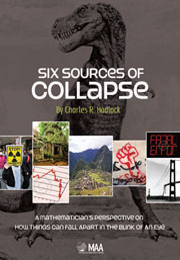 Six Sources of Collapse
Six Sources of Collapse Book contents
- Frontmatter
- Preface
- Acknowledgements
- Contents
- 1 Introduction
- 2 Predicting Unpredictable Events
- 3 Group Behavior: Crowds, Herds, and Video Games
- 4 Evolution and Collapse: Game Playing in a Changing World
- 5 Instability, Oscillation, and Feedback
- 6 Nonlinearity: Invitation to Chaos and Catastrophe
- 7 It's All About Networks
- 8 Putting It All Together: Looking at Collapse Phenomena in “6-D”
- References
- Index
- About the Author
8 - Putting It All Together: Looking at Collapse Phenomena in “6-D”
- Frontmatter
- Preface
- Acknowledgements
- Contents
- 1 Introduction
- 2 Predicting Unpredictable Events
- 3 Group Behavior: Crowds, Herds, and Video Games
- 4 Evolution and Collapse: Game Playing in a Changing World
- 5 Instability, Oscillation, and Feedback
- 6 Nonlinearity: Invitation to Chaos and Catastrophe
- 7 It's All About Networks
- 8 Putting It All Together: Looking at Collapse Phenomena in “6-D”
- References
- Index
- About the Author
Summary
A quick review
We started in Chapter 1 with a broad survey of types of phenomena subject to collapse, surely not all inclusive but certainly representing a wide range of subject areas, time frames, spatial dimensions, and dynamics. You may recall from Table 1.1 in that chapter that these ranged from empires to fads, galaxies to tumors, companies to civil order. There are certainly many ways to study and learn about these phenomena and about their vulnerability to collapse. These may variously include, depending on the particular subject matter: historical analysis, scientific data collection or experiments, logical or theoretical argument, expert opinion, or other methodologies. I asserted that the use of mathematical models is a particularly useful method in that it enables us to see commonalities across a wide range of cases from different subject areas and thus to get better insight on the underlying dynamics of many collapses. It has the additional advantage of offering a language that lets us depict these common dynamics efficiently and clearly in symbolic and graphical ways, as have been utilized throughout the previous chapters.
In the subsequent six chapters, we looked at six mathematical frameworks and how they might be applied to seemingly diverse areas of collapse. These are the “six sources of collapse” referred to in the title of this book and the six dimensions suggested in the title of this chapter. They include low probability events, group behavior, evolutionary processes, instability, nonlinearity, and networks. A brief summary of each is given in Table 8.1.
- Type
- Chapter
- Information
- Six Sources of CollapseA Mathematician's Perspective on How Things Can Fall Apart in the Blink of an Eye, pp. 173 - 188Publisher: Mathematical Association of AmericaPrint publication year: 2012


